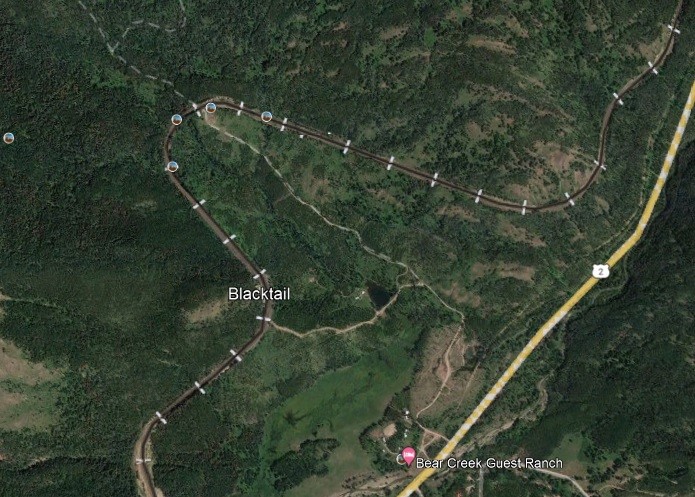Blacktail Siding and Horseshoe Curve
Introduction
Text-to-speech Audio
We are coming to an area known as Blacktail Siding. Here the train will go around a horseshoe curve. We should be able to see both ends of the train at the same time. Trains aren’t like cars that can make a quick turn around a right-angle corner. In fact, the track in this horseshoe curve is about the maximum curvature a train can negotiate. In 1985 a westbound freight train derailed and spilled hundreds of tons of corn in this area. Despite efforts by railway crews to clean up the spill, both black and grizzly bears came to feed on the corn. “By the spring of 1987 the corn had fermented, and officials began receiving reports of bears getting tipsy after eating the spoiled spillage. News reports about the ‘drunken bears’ in Glacier Park were carried around the world, and flocks of spectators soon began gathering. Concerned about erratic behavior of the bears and the large number of people gathering, officials closed the area and mixed the leftover corn with lime, hoping the chemical reaction would stop the aroma from attracting bears.” The lime may have helped, or the fermentation process may have simply run its course, but only one group of grizzly bears was sighted in the area the following year. Three more derailments involving a total of more than 100 grain cars came during the winter of 1988-1989, dumping some 10,000 tons of grain and corn on the hillside. “The bears awoke in spring and began to assist in the cleanup. Rangers tell of 11 bears at any one time gorging on the mounds of corn. So blissfully content was one grizzly that it lay down on its side and simply scooped corn into its face until it could eat no more. Little bears ate peaceably right along with the big ones, and even some black bears – which normally flee at the sight of the bully grizzlies – came to join in the feast. Wildlife biologists figure that bears will remember and visit the scene each spring just to double check for as long as they live, which for grizzlies is about 25 years.
Images

Backstory and Context
Text-to-speech Audio
In the valley below lies the now-vanished town of McCarthyville. This timber and railroad construction town prospered for only two or three years in the early 1890s. It was located at the farthest point horse-drawn vehicles could travel up Bear Creek toward Marias Pass. Because of its isolation, it was an ideal hideout for criminals running from the law. Some called it “the toughest town in Montana.” In its brief heyday, McCarthyville was home to about 1,000 residents, 32 saloons, numerous gambling halls, and eight “houses of ill-fame.” Its cemetery eventually contained about 200 graves, many the victims of gunshot wounds. A makeshift infirmary was built by the railroad who hired a veterinarian to treat the injured. He was paid $1 for each patient. Many of his patients soon went out the back door and were added to the cemetery population. Things did not improve until a mob took matters into their own hands and chased the doctor out of town. McCarthyville did boast of one new resident---a healthy baby boy born in 1891. The town was gradually abandoned after the completion of the Great Northern Railway route through the area. Most of the buildings caught fire and burned to the ground in 1921. About all that remains today are two structures, one of which once housed the post office. One of McCarthyville’s most colorful characters was William “Slippery Bill” Morrison, one of the first seasonal rangers appointed in the Lewis and Clark National Forest Reserve in 1901. Although he staked out a 160-acre claim and built a cabin at Marias Pass Summit, it was said that he’d rather make $10 gambling than $100 any other way. He got his name around 18 90 in a poker game. It was getting late and Bill was a heavy winner. He realized that his chances of leaving the game and getting home with his winnings were almost nil, so he pocketed most of his winnings. Leaving a small amount of money on the table, Bill left the game, announcing that he would “be right back.” He skipped town and made it home safely, thus earning the nickname “Slippery Bill.” Morrison Creek and Slippery Bill Mountain are named for him and can be found a few miles south of the summit in the Flathead National Forest.
Sources
2017 ROUTE GUIDE, Condensed Historical and Natural Science Material from the Complete Resource Guide, Empire Builder – Amtrak Train 8 Between Edmonds, Washington and Havre, Montana, NPS
Photo - Google Earth
